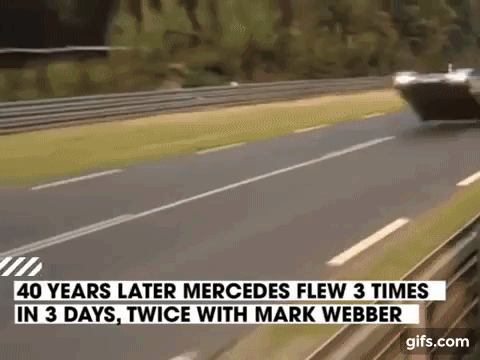Wanna See a Flying Mercedes-Benz Racecar?
The Flying Car Isn’t The Future, It’s The Past
Driving racecars isn’t a profession you go into if you’re squeamish about extreme, even life-threatening crashes. Part of making cars go fast is developing aerodynamic packages that allow the cars to slip through the air so they can accelerate and corner more quickly. But as one Mercedes racer learned the hard way, too much aerodynamic lift can result in the car literally taking flight. In that 1955 crash, 83 people lost their lives.
That’s just one of the wrecks featured in this new video above from Donut Media.
A Challenge of Aerodynamics
Fast forward to the modern era. Despite an uncanny amount of scientific progress, the problem of engineered lift is still a challenge. With cars reaching faster and faster speeds, engineers play a constant balancing act. They vacillate between downforce, which helps cars corner with traction but reduces acceleration, and lift, which aids acceleration. But in extreme situations, it can make cars fly.
Just ask Marc Weber, the famed Formula One driver and the pilot of Mercedes’ CLR racecar at the 1999 24-hours of Le Mans. He endured not one but multiple airborne wrecks in the car. The first two incidences took place away from the camera, leaving Mercedes skeptical if the car had indeed been airborne. But a third incident in qualifying was captured on film.
Along the famous Mulsanne Straight at France’s Circuit de La Sarthe, with the CLR achieving maximum acceleration from its 600-horsepower V8, the car’s nose suddenly lifted off the ground. The rest of the CLR’s chassis followed, catapulting Weber into the air. The car did two violent backwards somersaults and then rejoined the ground, destroying its rear suspension in the process.
Making Race Cars Safe
Without a functional car, Weber was unable to compete in the race, and furious at Mercedes, who failed to take his word that the car was getting light.
The visually-impressive crash would go onto inspire new safety measures designed to protect drivers and fans from the threat of an airborne car. These included heightened catch walls between the track and spectators, as well as new aerodynamics for cars that favored downforce.
In the popular NASCAR series, where similar flying-car spectacles had occurred in the past, manufacturers introduced roof flaps designed to deploy when cars get out of control.
The results of these efforts have been largely positive. While it’s difficult to imagine that racing will ever take place without wrecks or danger, the number of airborne incidents has greatly reduced. And spectator safety is at an all-time high, thanks to the new protective measures.

